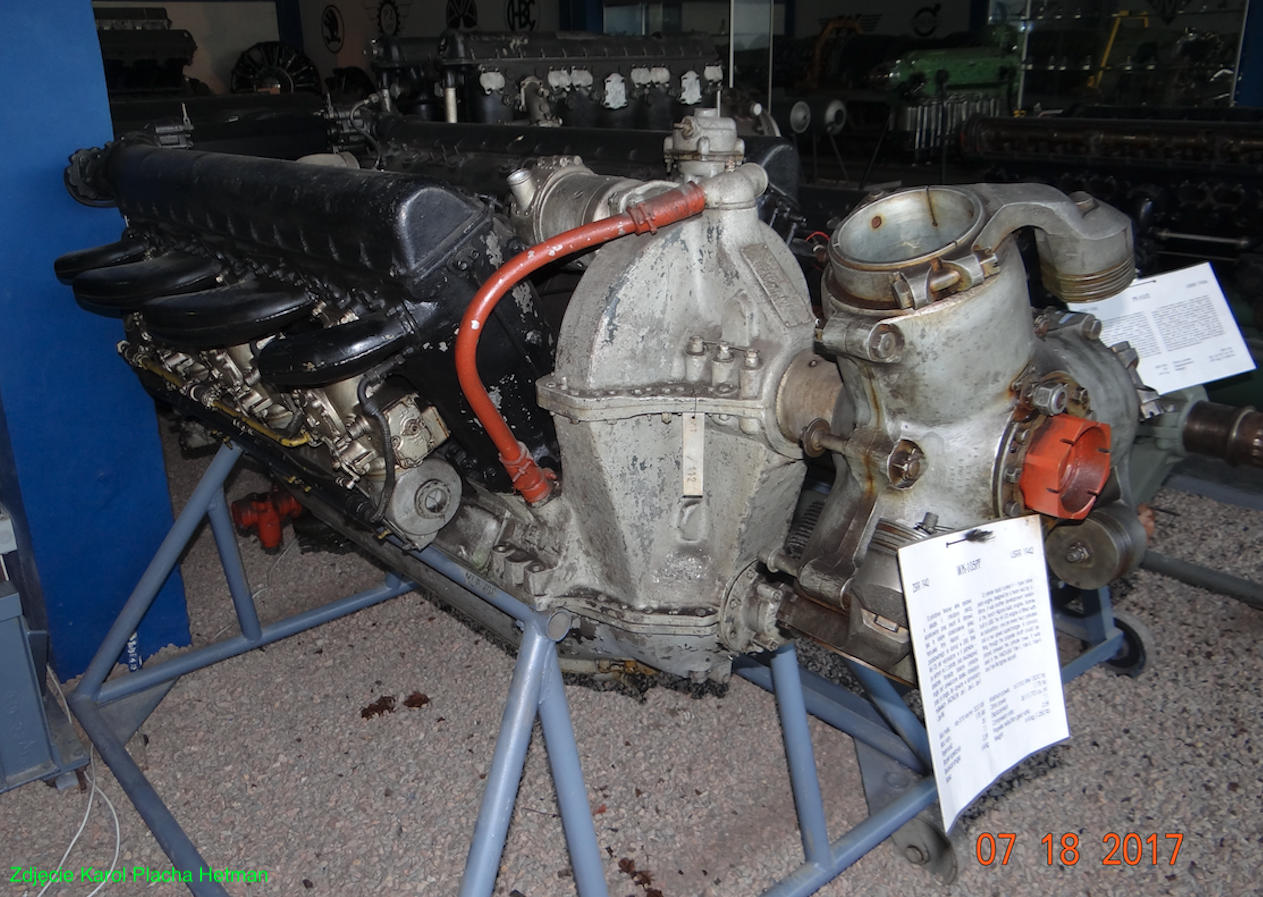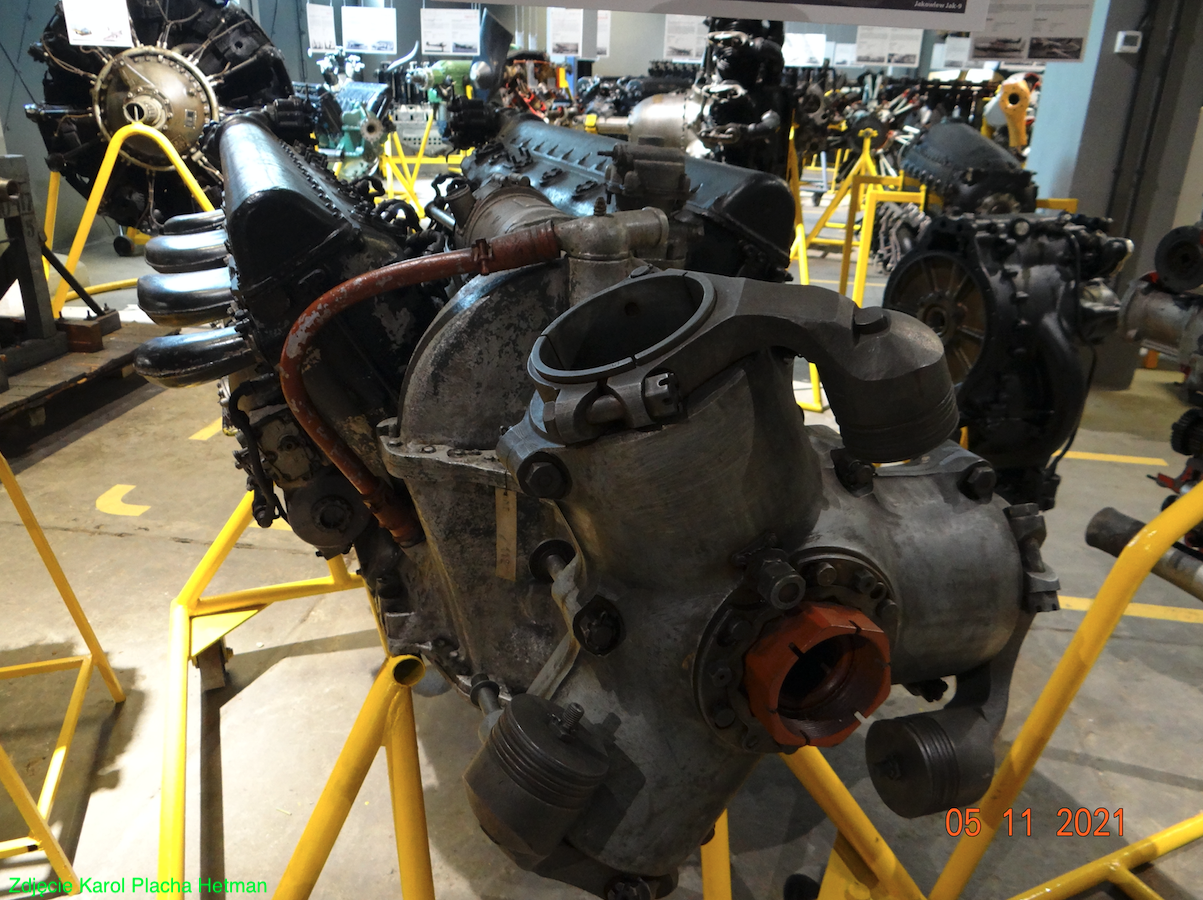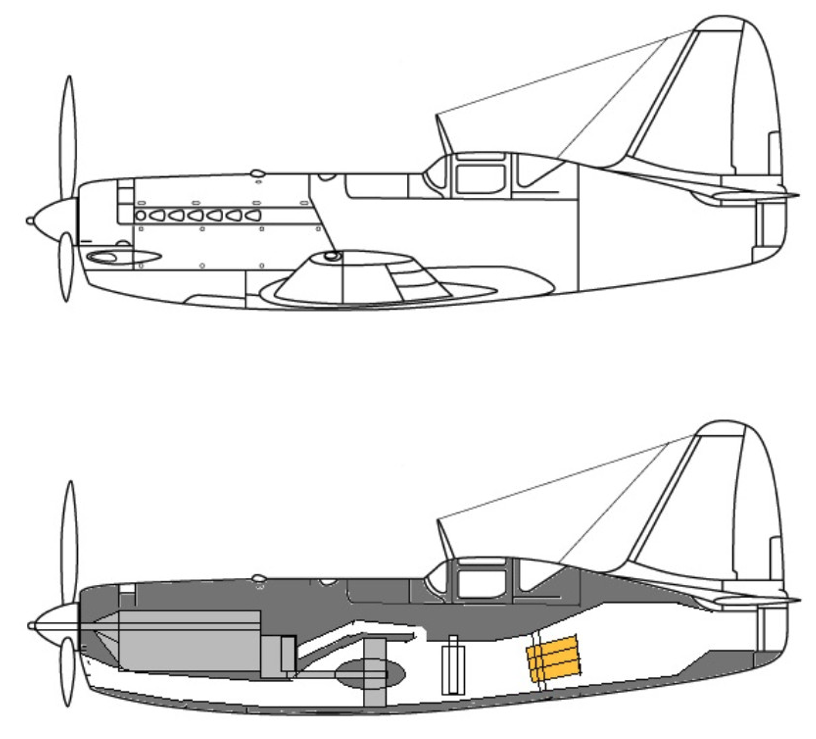Kraków 2016-06-26
Silnik typu motorjet


Opis zdjęcia: Taki przerobiony silnik, który oznaczono WK-107 R, służył do napędu sprężarki odrzutowej w samolocie I-250.

Napęd odrzutowy.
Napęd odrzutowy samolotu to określenie aktualnie potoczne i używane dla wskazania, że chodzi nam o samolot z napędem turboodrzutowym. Chociaż napędów odrzutowych jest dużo większa gama. Odrzutowym jest silnik rakietowy i silnik pulsacyjny, a takowych współczesne samoloty nie posiadają. Postaram się wyjaśnić, dlaczego tak się stało.
W poprzednich rozdziałach zwróciliśmy uwagę na fakt, że już w 30-latach osiągnięcie prędkości 700 km/h przez napęd śmigłowy jest niemożliwe. Problemem jest właśnie śmigło. Ma ono wysoką sprawność do momentu kiedy końcówki łopat nie przekraczają prędkości dźwięku. Kiedy przekroczą tę prędkość, sprawność śmigła drastycznie spada, więc samolot zmniejsza prędkość. I nie pomoże tutaj wzrost prędkości obrotowej tego śmigła. Opracowywanie w 90-latach XX wieku śmigła z wąskimi końcami dla likwidacji zjawisk naddźwiękowych na niewiele się zdają.
Rozpoczęto poszukiwanie innej formy napędu. Fantastycznych pomysłów było wiele. Jednak wszystkie one kierowały się w stronę napędu odrzutowego. Ostatecznie opracowano silniki typu: rakietowego, motorjet, strumieniowe, pulsacyjne i turboodrzutowe. Wszystkie one były rozwijane mniej więcej w tym samym czasie. Te ostatnie stały się podstawowym źródłem napędu współczesnych samolotów. O tym wszystkim będzie mowa.
Trochę o dawnej historii.
Już w XVI wieku, Leonardo da Vinci wykonał szkic komina w którym zamontowane byłyby wiatraki poruszane przepływającym dymem. W 1629 roku, Giovanni Brance opracował konstrukcję młyna bijakowego poruszanego odrzutem wydostającej się pod dużym ciśnieniem pary wodnej. W kolejnych latach opracowano co najmniej kilka silników parowych, które wykorzystywały wyrzut pary wodnej pod ciśnieniem. Były między innymi tego typu silnik przystosowane do napędu sterowca lub pojazdów szynowych. Był to czas kiedy ludzkość weszła w „Wiek pary”.
W 1910 roku, Rumuński inżynier Henri Coanda skonstruował i zbudował pierwszy na świcie samolot z napędem odrzutowym. Samolot był wyposażony w silnik tłokowy o stosunkowo niewielkiej mocy. Silnik nie poruszał typowego śmigło, tylko rodzaj wirnika z łopatkami, który był okryty tunelem. Za wirnikiem był wtrysk dodatkowego paliwa, który miał zwiększyć moc zespołu napędowego. Podczas prób kołowania konstruktor uruchomił cały zespół napędowy. Jednak pilot zauważył, że płomienie są niezwykle duże i zaczyna pali się poszycie samolotu. Pilot nawet nie zauważył, że maszyna oderwała się od ziemi. Omal nie doszło do katastrofy. Po tym incydencie konstruktor porzucił dalsze prace nad tym wynalazkiem. Zdarzenie to jest obecnie tak doniosłe dla Rumunów, że ich międzynarodowy port lotniczy nosi imię Henriego Coandy. Do tego pomysłu powrócono po 20-stu latach.
Osiągnięcia włoskie.
Wydawać by się mogło, że nad silnikami odrzutowymi pracowali tylko Anglicy i Niemcy. Jednak spore osiągnięcia mieli także włosi. Jedną z wielkich postać lotnictwa włoskiego był Giovanni Battista Caproni (1886-1957). Był twórcą pierwszego włoskiego samolotu (1910 rok), pierwszego na świcie samolotu bombowego (1914 rok), pierwszego wielkiego samolotu pasażerskiego zabierającego 100 pasażerów (1920 rok). Giovanni Caproni swoje samoloty budował we własnej wytwórni Società Italiana Caproni, którą założył w 1908 roku. Na przestrzeni czasu nazwa firmy kilkakrotnie ulegała zmianie.
Płatowiec samolotu był niezwykle nowoczesny. Całkowicie metalowy dolnopłat, z chowanym podwoziem. Brakowało, aby podwozie miało przednie podparcie, a nie tylne kółko ogonowe. Kadłub w postaci długiej rury z kabiną dwumiejscową w układzie tandem, całkowicie krytą. Zespołem napędowym był motorjet (silnik tłokowo-odrzutowy). Zespół napędowy rozpoczynał się centralnym, okrągłym chwytem powietrza za którym znajdował się centralny stożek wlotowy kierujący powietrze do pierścieniowego kanału. Dalej znajdowała się 3-stopniowa sprężarka. Łopatki sprężarki mają zmienny kąt nastawienia. Sprężarka poprzez przekładnię była napędzana przez znajdujący się dalej silnik tłokowy. Jest to silnik Isotta Fraschini L.121 RC.40 o mocy 900 KM (670 kW), zbudowany w układzie dwu-rzędowym, 12 cylindrowy, chłodzony cieczą. Kanał powietrzny omija silnik, kabinę załogi, kadłubowy zbiornik paliwa. Dalej znajduje się komora spalania do której poprzez wtryskiwacze jest podawane paliwo, które spalając się wytwarza ciąg. Komora spalania kończy się dyfuzorem i dyszą wylotową. Regulacja siły ciągu i przyśpieszenie odbywało się za pomocą umieszczonego w dyszy wylotowej stożka. Campini swój zespół napędowy nazywał „termojet”. Wynalazcy dokonywali prób z różnym paliwem: naftą, olejem napędowym i innymi.
Motorjet.
Co to jest motorjet, czyli silnik tłokowo-odrzutowy? Motorjet składa się ze sprężarki (zwykle promieniowej), która napędzana jest silnikiem tłokowym. Zwykle był to silnik tłokowy-gwiazdowy. Sprężone powietrze w komorze otrzymywało wtrysk paliwa. Powstała mieszanka zapalała się. Rozszerzone gwałtownie gazy wydostawały się przez dyszę wylotową w postaci strumienia (jet) i wytwarzały ciąg. Przy danej mocy silnika tłokowego ciąg takiego zespołu napędowego jest znacznie większy niż dałoby śmigło. Czasami silnik ten nazywano silnikiem Campiniego, od jego twórcy. W dzisiejszej nomenklaturze jest to sprężarka kanałowa z dopalaczem.
Napęd tego typu okazał się mniej sprawny od silników turboodrzutowych. Głównym powodem był zbyt mały spręż powietrza i większe zużycie paliwa. Sam zespół napędowy był bardziej skomplikowany. Niemniej jednak ten układ działał i skutecznie napędzał samolot. Jego zaletą był brak turbiny. Najbardziej trudnego do wykonania elementu, a przez to kosztowanego w produkcji z powodu przenoszenia dużych obciążeń i pracy w wysokiej temperaturze. Inną zaletą była pojedyncza komora spalania, a nie komory dzbanowe lub pierścieniowe. Również łatwiej było tę komorę schłodzić z zewnątrz, dlatego mogła wytrzymać wyższe temperatury pracy.
Doświadczenia w CCCP. MiG I-250.
Rosjanie rozwinęli napędy mieszane nie rezygnując z typowego śmigła. U podstaw takiej filozofii była chęć uzyskiwania chwilowych dużych prędkości bez rezygnacji z zalet samolotu śmigłowego. Bardziej złośliwi twierdzą, że u podstaw leżało zacofanie techniczne. Naszym zdaniem, przyczyną był po prostu brak silnika turboodrzutowego. Niemniej jednak, w ten sposób rosjanie opracowali kilka interesujących konstrukcji. Najbardziej znane są I-250 oraz Su-5.
Biuro OKB Mikojana i Guriewicza przystąpiło do pracy nad samolotem o napędzie śmigłowo-odrzutowym w maju 1944 roku. Samolot oznaczono I-250, a w produkcji MiG-13. Napęd kombinowany składał się z tłokowego silnika rzędowego WK-107R (będącego przeróbką silnika WK-107A) wykorzystywanego w samolotach Jakowlew Jak-9 P oraz już produkowanych po wojnie Jakowlew Jak-3. Zastosowano 3-łopatowe śmigło, o średnicy 3,1 m. W tym układzie silnikiem odrzutowym był silnik motorjet oznaczony WRDK, o ciągu około 4,3 kN. Silnik tłokowy przede wszystkim napędzał śmigło, ale także poprzez przekładnię i wał silnik, a w zasadzie sprężarkę WRDK. Oba zespoły napędowe (silnik tłokowy i mtorjet) pracowały na tym samym paliwie. Łączna przeliczeniowa moc zespołu napędowego wyniosła 2 560 KM (1 882,87 kW). Nie do końca znana jest moc silnika WK-107R. Według różnych źródeł wynosi ona od 1 250 KM do 1 500 KM, z tym, że moc 1 500 KM osiągał silnik WK-107A, który nie posiadał przekładni na napęd WRDK. Natomiast Samolot wykonano jako całkowicie metalowy dolnopłat.
WKRD (BKPД) – powietrzny odrzutowy silnik sprężarkowy. Воздушный компрессор воздушно-реактивный двигатель.
Pierwszy egzemplarz samolotu otrzymał oznaczenie I-250. Projekt był gotowy 28.03.1944 roku, drewniana makieta była gotowa 26.10.1944 roku, w dniu 30.11.1944 roku, gotowa była dokumentacja wykonawcza dla prototypu. Prototyp zbudowano zimą 1944/1945 rok i z końcem lutego samolot przechodził testy lotniskowe. W dniu 3.03.1945 roku, samolot z oznaczeniem I-250-01 pomalowany na biało i nazwany „Biała noc”, wystartował do pierwszego lotu. Za jego sterami siedział Aleksandr Diejew. Motorjet uruchomiono po raz pierwszy w trzecim locie. Trzeba było jednak przerwać kolejne loty i dokonać poprawek usterzenia, które okazało się mało skuteczne. Po modyfikacji usterzenia w dniu 23.05.1945 roku, samolot I-250-01 osiągnął prędkość 825 km/h na pułapie 7 800 m. W kolejnym locie pilot Aleksandr Diejew zginął, gdy od samolotu odłamała się część usterzenia. Pilot zdołał wyskoczyć, otworzyć spadochron, ale odległość od ziemi była zbyt mała. Wpływ motorjet był znaczny. Na samym silniku tłokowym samolot osiągał prędkość max 677 km/h. Z analiz wynikało, że napęd odrzutowy dodawał zespołowi napędowemu 30 % mocy. Jednak drastycznie wzrastało zużycie paliwa.
Drugi prototyp I-250-02 otrzymał wzmocnioną konstrukcję i powiększone usterzenie oraz wiele innych drobnych zmian. Samolot oblatał Aleksiej Jakimow. Samolot był pomalowany na granatowo z żółtymi pasami na kadłubie i nazwano „Niebieska pończocha”. Silnik WRDK pełnił jednak tylko rolę przyspieszacza. Można go było uruchamiać tylko na 2-3 minuty. Łączny czas pracy nie przekraczał 10 minut, po czym nadawał się tylko do remontu. Niezależnie od tego, czy dopalacz pracował czy nie, sprężarka zawsze się kręciła. Chodziło o to, aby w kanele powietrznym nie występował zator powietrza, co wydatnie by ograniczało prędkość samolotu. Prędkość obrotowa sprężarki wynosiła około 30 000 obr/min. Według danych ciąg WRDK wynosił 4,3 kN. Przeliczeniowa moc całego zespołu napędowego wynosi około 2 560 KM. (Od razu zaznaczę, że przeliczenie ciągu na moc nie jest takie proste, bo nie ma zwykłego matematycznego równania i jest ono liczone dla konkretnego przypadku.).
Samolot był trudny w pilotażu, bo z chwilą włączenia silnika motorjet zmieniały się charakterystyki lotne. Poza tym pilotowanie nakładało na pilota dodatkowe czynności. Sama obsługa naziemna samolotu była dłuższa niż maszyny klasycznej i wymagała dodatkowej wiedzy i umiejętności oraz sprzętu.
Najbardziej zaskakujące w układzie napędowym było pozostawienie śmigła, które jako takie jest głównym problemem w osiąganiu prędkości ponad 700 km/h. świadczy to o konserwatywnym podejściu konstruktorów do nowych zespołów napędowych w tamtym czasie. Próby I-250 trwały przez trzy miesiące i podjęto decyzję o zbudowaniu serii 50 maszyn, mimo że samolot był wciąż niedopracowany. Samoloty trafiły do próbnej eksploatacji do lotnictwa wojskowego (morskiego) i służyły do 1950 roku. Prawdopodobnie zbudowano 10-15 egzemplarzy, a kilka innych było w różnym stanie montażu. Oznaczenie wojskowe to MiG-13, które prawdopodobnie został nadane zaocznie. W OKB MiG samolot miał kryptonim „N”. Maszyny były cięższe od samolotów doświadczalnych, bo otrzymały uzbrojenie i radiostację łączności. Przez to miały gorsze osiągi i znacznie dłuższy rozbieg. Samolot MiG-13 miał znikomy zasięg z uwagi na mała ilość miejsca na zbiornik paliwa w kadłubie. Dlatego już na etapie produkcji seryjnej MiG-13 otrzymał dodatkowy wewnętrzny zbiornik paliwa o pojemności 190 litrów. W ten sposób całkowita ilość zabieranego paliwa wzrosła do 780 litrów. Zasięg wzrósł do 780 km bez użycia napędu motorjet. To jednak ponownie pogorszyło charakterystyki startu i prędkości samolotu, bo samolot startował wyłącznie przy użyciu napędu śmigłowego. Początkowo samolot był uzbrojony w 1 działko i 2 wkm, które zamieniono na 3 działka 20 mm. Samolot MiG-13 nigdy nie trafił do prób państwowych. Jego obsługa była bardzo czasochłonna i skomplikowana. Maszyna była trudna w pilotażu, a z chwilą włączenia silnika jet charakterystyki lotne ulegały znacznej zmianie.

Suchoj Su-5.
Identyczne zadanie – Zbudowania samolotu myśliwskiego z napędem mieszanym, tłokowy 12-cylindrowy WK-107R o mocy 1 225 kW oraz silnika motorjet WRDK o ciągu 3-4 kN – otrzymał zespół Suchoj. Samolot oznaczono Su-5, a oznaczenie w biurze I-107. Samolot był barzo podobny do MiG-13. Różnił się jednak kilkom szczegółami. Zastosowano 4-łopatowe śmigło o średnicy około 2,9 m. Przeliczeniowa moc całego zespołu napędowego wynosi około 2 600 KM.
Kabina pilota zajmowała centralną część kadłuba. Samolot planowano uzbroić w 1 działko NS-23 kal 23 mm (100 pocisków) strzelające przez piastę śmigła oraz 2 wkm umieszczone w skrzydłach Berezin UB 12,7 mm (200 pocisków).
Prototyp pierwszy lot wykonała w dniu 6.04.1945 roku. Osiągnięto prędkość max 810 km/h na wysokości 7 800 m. Podczas prób silnik tłokowy przegrzał się i uległ zatarciu. Brak zastępczego silnika WK-107R spowodowało przerwanie testów i program zawieszono. Z chwilą pojawienia się samolotów z napędem turboodrzutowym MiG-9 oraz Jak-15 prace nad I-250 oraz Su-5 całkowicie porzucono.
Silnik typu mototjet okazał się nierozwojowy. Miał dużą masę całkową z uwagi na zastosowanie silnika tłokowego. Sprawność sprężarki była ograniczona z uwagi na zbyt małe prędkości obrotowe. Miał duże zużycie paliwa, przy niskim ciągu. Łączny przekrój poprzeczny silnika tłokowego i kanału powietrznego jest duży, co skutkuje trudnością w zabudowie zespołu napędowego oraz słabymi charakterystykami aerodynamicznymi kadłuba.
W dzisiejszej literaturze podaje się, że napęd typu motorjet był rozwiązaniem zastępczym, co jest stwierdzeniem nieprawdziwym. Problem w tym, że był to taki sam kierunek poszukiwania nowego napędu „bez śmigła” jak silniki turboodrzutowe, silniki strumieniowe i silniki rakietowe. Po prostu jeden z tych kierunków okazał się lepszy (silnik turboodrzutowy) i zdominował lotnictwo. Choć po prawdzie nie zlikwidował całkowicie śmigła w lotnictwie.
Opracował Karol Placha Hetman
